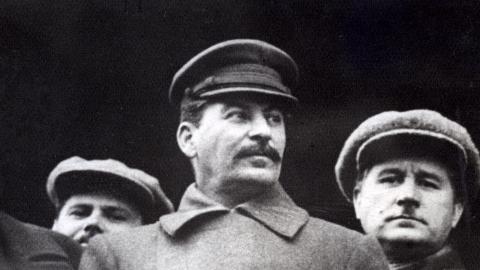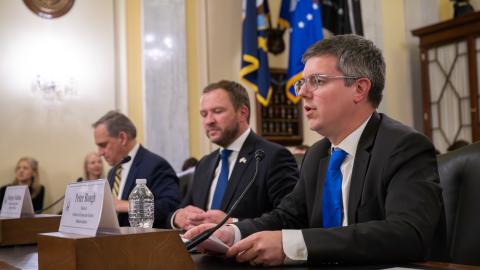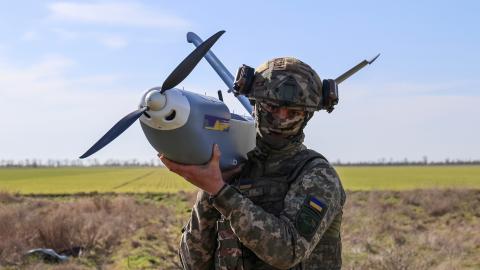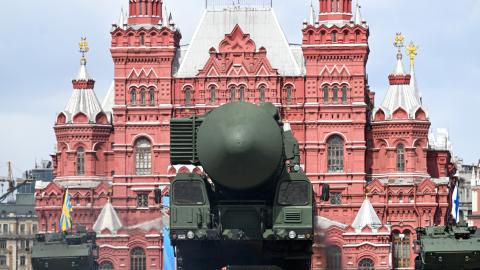For a recent example of the rapidity of change in the international security environment, one should look to the United States’ most recent Nuclear Posture Review (NPR). Though it was released in 2022, nearly all its policy aims and expectations are already out of date. With Joint Chiefs of Staff Chair General Dan Caine warning last week that he does not believe Russia will stop at Ukraine, and with Russian President Vladimir Putin boasting that his country is the “highest of all nuclear powers,” Washington needs to update its understanding of the new nuclear balance.
In its NPR, the Biden administration sought to place “renewed emphasis on arms control [and] nuclear non-proliferation.” Doing so, it believed, would enable the president to “pursue opportunities to reduce the role of nuclear weapons globally, enhance strategic stability with the [People’s Republic of China] and Russia, and reduce the risks of war or escalation during war.”
But nuclear weapons are now central to the diplomatic aspirations of four nuclear-armed (or near-nuclear-armed) US adversaries—China, Russia, Iran, and North Korea. These increasingly aligned states have signed a series of diplomatic, intelligence, defense-industrial, logistics, and military agreements. Additionally, arms control and nuclear nonproliferation frameworks constructed during the Cold War have ceased to meaningfully constrain Russian nuclear weapons programs. Russia has withdrawn from the Comprehensive Test Ban Treaty, which suggests that it will resume nuclear testing and will not extend New START (Strategic Arms Reduction Treaty). Moreover, emerging doubts about the US commitment to global nuclear deterrence are emboldening Moscow’s nuclear weapons development and deployment aspirations. And Russia’s 2022 full-scale invasion of Ukraine signaled a definitive end to the accords concerning Ukrainian sovereignty and territorial integrity: the 1994 Budapest Memorandum and the 2014 and 2015 Minsk agreements.
Most fundamentally, US policy choices since Russia’s invasion have given US allies and adversaries alike reason to believe that nuclear threats are an effective means of deterring the US. The widespread recognition that the US could be deterred from taking actions otherwise in its interest set in motion a sequence of Russian initiatives that have adversely affected the credibility of US nuclear deterrence and nuclear nonproliferation aims more broadly.
Russia’s Deployment of Nuclear Threats to Coerce the US
The Biden administration’s cumulative policy choices regarding Ukraine have diminished the credibility of the US nuclear deterrent and encouraged several nations’ nuclear aspirations. Before the conflict began, the US had already limited its policy options. In December 2021 President Joe Biden removed any fear President Putin might have had that the US military would intervene in Ukraine, announcing the US would respond only by imposing economic sanctions. Recalling American forces’ shambolic retreat from Afghanistan less than a year earlier, the administration also confirmed that it had plans to evacuate US citizens from Ukraine in the event of an invasion, further affirming Washington’s intention to distance itself from the conflict.
Russian manipulation of coercive nuclear threats to constrain US policy choices. The Center for Strategic and International Studies documented that Moscow threatened nuclear use more than 200 times from 2022–23 in its survey Nuclear Signaling During the War in Ukraine. The United Kingdom House of Commons also published a research briefing in December 2024 summarizing Russia’s coercive nuclear threats (see appendix). President Biden viewed Russia’s nuclear threats as credible and perceived the risk to be apocalyptic.
In October 2022 President Biden indicated that President Putin was “not joking” about his readiness to use nuclear weapons, positing that therisk of a nuclear “Armageddon” was at its highest level since the 1962 Cuban Missile Crisis. The president also rejected Poland’s offer to facilitate the transfer of Soviet-era aircraft to Ukraine, stating that doing so meant “World War III.”
The consequences of the administration’s decisions are likely to be enduring. Several allied nonnuclear states are now considering the acquisition of nuclear weapons. In addition, the North Atlantic Treaty Organization and European Union are reviewing proposals to establish a European nuclear deterrent as a substitute for the US nuclear umbrella.
Finally, Russia’s repeated breach of the Nuclear Non-Proliferation Treaty’s clause against the manipulation of nuclear threats against a nonnuclear state has changed nonnuclear states’ calculus on whether to acquire nuclear weapons. Acquiring nuclear weapons now appears to be the only way for nonnuclear states to deter attacks—even nonnuclear ones—by nuclear states.
Russia’s Lowering of the Threshold for Nuclear Use
Russia successfully demonstrated that its nuclear threats could deter the US from providing modern defensive capabilities to Ukraine. To exploit this, Moscow changed its policy on nuclear use in its November 2024 declaration “Fundamentals of State Policy of the Russian Federation on Nuclear Deterrence.”
The Kremlin’s new policy holds at risk the basis for nuclear stability between the US and Russia. It states that Russia may use nuclear weapons in a conventional conflict that “creates a critical threat to [Russia’s and Belarus’s] sovereignty and (or) territorial integrity.”
In 2022 the Kremlin formally annexed four Ukrainian oblasts that Russia had at least partially captured in its 2014 and 2022 invasions: Donetsk, Kherson, Luhansk, and Zaporizhzhia. It also formally annexed Crimea, although it had completed its conquest of the region in 2014. Residents in the occupied regions became Russian citizens and were obliged to carry Russian passports. Therefore, under the 2024 policy, Russia could employ nuclear weapons in response to Ukraine’s effort to recover its rightful territory, as doing so could pose “a critical threat” to Russia’s “territorial integrity.”
Russia’s Development, Production, and Deployment of Advanced and Novel Nuclear Weapons and Delivery Systems
Russia’s recent nuclear weapons policy has contravened the US commitment to reducing the role of nuclear weapons in international affairs. Russia’s foreign policy has instead relied on broadening the threat of nuclear use.
Russia’s treaty-based collaboration with China, Iran, and North Korea, particularly in the defense industrial realm, has helped Moscow realize its expanded nuclear weapons aspirations. North Korea produces an advanced version of Russia’s Iskander ballistic missile, as well as over half the munitions Russia uses in Ukraine. Russia is assisting China to increase Beijing’s production of plutonium for its rapidly increasing theater and strategic nuclear forces. China, Iran, and Russia have built an extensive transportation network (the International North–South Corridor) from Moscow through the Caspian Sea to Iran to evade sanctions intended to limit their access to advanced military technology.
In 2022 Russia deployed nuclear weapons outside its own borders for the first time, starting with the air-launched hypersonic Kinzhal missile. The Kremlin has deployed dozens more nuclear weapons to Belarus since then. In 2024 Belarus agreed to accept the deployment of Russia’s newest ballistic missile, theOreshnik. This hypersonic missile, derived from Russia’s RS-26 intercontinental ballistic missile (ICBM), has a range of around 1,800–3,400 miles (3,000–5,500 kilometers), which would allow it to target all of Europe and the Middle East.
In 2018 President Putin announced the development of novel types of intercontinental nuclear weapon delivery systems:
ICBMs. Sarmat ICBM is an evolution of the Cold War–era SS-18 ICBM. This missile has sufficient range to fly over the South Pole to avoid Alaska-based US missile defenses.
Hypersonic delivery systems. Russia has developed three new systems capable of flying at speeds between Mach 5 and Mach 20:
- Kinzhal is based on the Iskander short-range ballistic missile. It is launched from a modified MiG-31 tactical aircraft to a high altitude and then embarks on an aeroballistic trajectory. It has a 1,250-mile (2,000-kilometer) range and can be equipped with a nuclear or nonnuclear payload. It is also deployed in Belarus.
- Avangardis a hypersonic boost-glide vehicle designed to be launched from an ICBM to evade missile defenses and strike high-value infrastructure targets. The missile can reach Mach 20. It is believed to be made from an advanced composite material to withstand the high temperature of hypersonic flight.
Tsirkonis a hypersonic naval missile with a top speed between Mach 5 and 6 and a range of roughly 300 miles (500 kilometers). Analysts expect it will be deployed on Russia’s Kirov-class cruisers.
New advanced strategic weapon delivery capabilities. Russia has developed or is developing three new types of delivery systems for strategic nuclear weapons:
- Burevestnik is a nuclear-powered, nuclear-armed subsonic cruise missile with around-the-world range. It is still under development.
- Poseidon is a nuclear-powered, nuclear-armed torpedo that can be launched from two specially equipped nuclear submarines, the Belgorod and the Khabarovsk. The submarines would carry six and eight Poseidon torpedoes, respectively. Each torpedo would be equipped with a two-megaton cobalt-jacketed nuclear warhead and have a 3,100-mile (5,000-kilometer) range. It would damage its target with some combination of blast, radiation contamination, and tsunami effects.
- Russia has a space-based systemthat would remain in orbit and could be armed with a nuclear weapon. US authorities reported that the Russian satellite Cosmos 2553, launched in 2022,may be intended to receive a nuclear weapons payload. This satellite is also reported to have developed orbital stability problems, though it could be easily replaced. In 2024 Russia vetoed a United Nations resolution designed to strengthen provisions in the Outer Space Treaty of 1967 against the deployment of nuclear weapons in space. Nuclear weapons in space are likely to be part of Russia’s larger terrestrial and space-based counter-space system, which will also include (1) direct-ascent antisatellite missiles, (2) co-orbital attack satellites, (3) satellite jamming and dazzling, and (4) strikes against enemies’ ground-based infrastructure.
Conclusions
Russia’s defense policy has evolved significantly since its invasion of Ukraine in February 2022. The coercive threat of use of nuclear weapons is likely to be integrated into Russian kinetic, gray zone, and cognitive warfare operations. Russia’s successful deployment of the coercive threat of nuclear weapons use deterred the US from undertaking actions in Ukraine that it likely would have taken absent Russia’s coercive nuclear threat. This success emboldened Russia to announce an even lower threshold for nuclear use, which aims to reinforce the credibility of its coercive nuclear threats. Russia’s post–Cold War nuclear weapons and delivery system enhancements have increased its diplomatic and military flexibility and the strategic value of its alliance with China, Iran, and North Korea.
Appendix: The UK House of Commons Report on Russian Nuclear Threats
President Putin, Foreign Minister Sergei Lavrov, and Dmitry Medvedev, deputy chairman of the Russian Security Council, frequently refer to Russia’s nuclear arsenal within the context of Ukraine. Among the more prominent statements and actions are:
- 24 February 2022 – President Putin warned against any interference in Ukraine from outside or of a direct attack on Russia and said Russia would respond immediately and the consequences would be “such as you have never seen in your entire history.”
- 27 February 2022 – President Putin orders Russian nuclear forces to move to a heightened status of alert. Putin said he was issuing this order in response to escalating economic sanctions and “aggressive statements” being issued by the West following Russia’s invasion of Ukraine.
- 20 April 2022 – Russia tests its new Sarmat intercontinental ballistic missile (ICBM), although the US was pre-notified of the test under the terms of the New START treaty.
- 12 May – Medvedev says NATO military aid to Ukraine risks conflict with Russia and “fully fledged nuclear war.”
- 21 September 2022 – In an address to the nation President Putin says that in the event of a threat to the territorial integrity of Russia, “we will certainly make use of all weapon systems available to us. This is not a bluff.”
- 30 September 2022 and 16 June 2023 – President Putin makes reference to the use of nuclear weapons in Hiroshima and Nagasaki, suggesting that the US had “created a precedent.”
- February 2023 – Russia suspends its participation in the New START treaty, threatens to resume nuclear testing and places new nuclear capabilities on combat duty, although does not specify which capabilities. The New START treaty, which is the only bilateral arms control treaty limiting the strategic nuclear arsenals of the US and Russia, expires in 2026.
- 25 March 2023 – Russia announces that it will deploy tactical nuclear weapons in Belarus.
- June 2023 – Russia restates that a return to New START would only be possible if the US abandoned its “fundamentally hostile policy toward the Russian Federation.”
- 21 June 2023 – President Putin confirms that the new Sarmat ICBM (Satan II) would be placed on combat duty “in the near future.”
- October 2023 – The Russian Parliament passes legislation de-ratifying the Comprehensive Test Ban Treaty (CTBT). The legislation is signed into law by President Putin in November 2023.
- February 2024 – In his annual address to the Federal Assembly, President Putin says that Russia’s strategic nuclear forces are on full combat alert and “the ability to use them is assured.”
- March 2024 – In an interview with Russian state TV, President Putin says Russia was prepared for nuclear war and that its nuclear capabilities were more advanced than its nuclear peers.
- May 2024 – Russia announces that it will conduct exercises to test the readiness of its non-strategic/tactical nuclear forces in a combat scenario. The exercises, which were the first of its kind, were announced in direct response to what Russia described as “highly destabilising actions” by NATO states, including suggestions that Western troops should be deployed on the ground in Ukraine and giving permission to Ukraine to use Western-supplied equipment to strike targets in Russian territory. The Ukrainian government called the exercises “nuclear blackmail.”
- September 2024 – President Putin announces that changes to Russia’s nuclear doctrine are under consideration.
- November 2024 – President Putin formally approves Russia’s new nuclear doctrine, on the same day that US authorisation is given for Ukraine to use US-supplied long-range missiles against targets in Russia.
- November 2024 – Russia uses a new experimental hypersonic ballistic missile (codename Oreshnik), against targets in Ukraine. The “combat test” of the Oreshnik was said to be in direct response to the use of US- and UK-supplied long-range missiles against targets in Russia. In December President [Aleksandr] Lukashenko suggested that the Oreshnik could be deployed at various sites in Belarus in 2025. It remains unclear whether Oreshnik is nuclear-capable.














